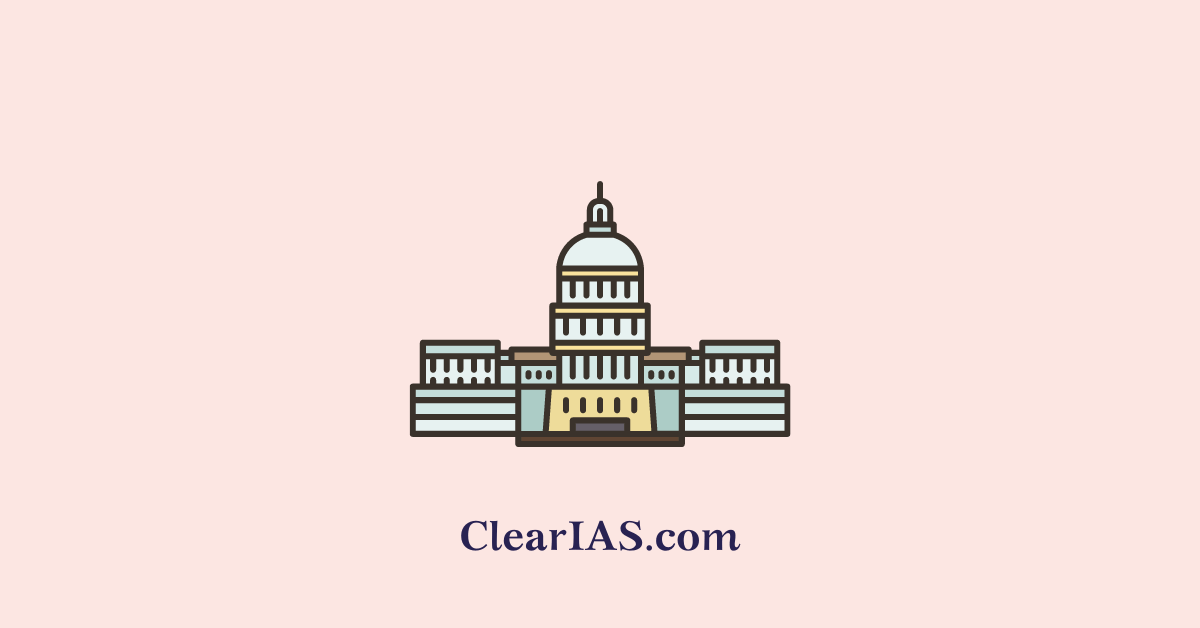 GoI (Government of India) Act 1935 was the result of the Third Round Table Conference (RTC), held in November 1932.
GoI (Government of India) Act 1935 was the result of the Third Round Table Conference (RTC), held in November 1932.
The third RTC was held again without the participation of Congress. The British parliament enacted the GoI Act in 1935, and it went into effect in 1937.
It was based on a report by a Joint Select Committee that established the two houses of the British parliament and was chaired by Lord Linlithgow.
At that time, it was the longest legislation passed by the British Parliament.
Main Features of the GoI Act, 1935
The Government of India Act of 1935 was a significant piece of legislation that marked a crucial phase in the constitutional development of British India. The Act was enacted by the British Parliament and came into effect in 1937. It replaced the Government of India Act of 1919 and remained in force until India gained independence in 1947.
The legislation was passed by the British Parliament in August 1935 and its main provisions were as follows:
Federal Level
Changes made at the federal level are:
Executive
- Dyarchy at the Centre- The executive authority of the Centre was vested in the Governor General. All the subjects that needed to be administered were divided into two subjects i.e., Reserved Subject and Transferred Subject.
- Reserved subjects were exclusively administered by the governor-general on the advice of executive councilors and included subjects like foreign affairs, tribal affairs, defense, etc.
- Note that, executive councilors were not responsible to the central legislature.
- Transferred Subjects were to be administered by the governor-general on the advice of ministers elected by the legislature.
- Here, Ministers were to be responsible to the legislature and are subject to resignation on losing the confidence of the body.
- On discharge of his special responsibilities, the governor-general could act at his discretion for the security and tranquillity of India.
Legislature– The Bicameral legislature was to have an upper house (council of states) and a lower house (Federal Assembly).
- Oddly, the election of the upper house (council of states) was direct and that of the lower house was indirect.
- The Council of State was made a permanent body and made a provision that one-third of the members will be retired every third year.
- As per the provision, the duration of the assembly was to be 05 years.
- The three lists of legislation were made i.e.,
- Federal List
- Provincial List
- Concurrent List
- Members of the legislative assembly were given the power to move a vote of no-confidence against ministers. Such power to move a no-confidence motion was not given to the Council.
- Further expansion of religion-based and class-based electorate.
- 80% of the budget was still non-votable.
- The Governor General enjoys the residuary power. and he could-
- restore cut in grants
- restore and certify bills rejected by the legislature
- can issue ordinances
- can exercise his veto.
Provincial Level
Changes made at the provincial level are-
- Provinces were made free from the directions of the Secretary of State and Governor General. Hence, provinces started deriving their authority directly from the British Crown.
- Dyarchy was replaced by provincial autonomy and a separate legal system was also granted to the provinces.
- Provinces were granted independent financial powers and resources. As per the Act, the Provincial government could borrow money for its security.
Executive
- The governor was to be the crown’s nominee.
- Governor holds special power regarding minorities, law, and order, rights of civil servants, British interests related to business, princely states, etc.
Legislature
- The separate electorate that was introduced under communal award was to be made operational.
- The franchise was extended and women were given the same rights as men.
- A provision was made that all the members were to be directly elected.
- Ministers were made answerable and removable by the vote of the legislature.
- The provincial legislature was given the power to legislate on subjects that fall under the provincial list as well as the concurrent list.
- 40% of the budget was still non-votable.
- Governor enjoys certain powers like-
- he could refuse to assent to a bill
- he can promulgate ordinances.
- can enact governor’s acts.
Other Points:
- Dyarchy, which was rejected by the Simon Commission was provided in the federal executive.
- Whereas, Dyarchy in the province was abolished and given provincial autonomy.
- In case of deadlock between the houses, there was a provision for joint sitting.
- The residuary list falls under the discretion of the Governor-General.
- The provincial legislature was further expanded.
- The communal electorate was further extended to depressed classes, women, and labor.
- The franchise was further expanded and about 10% of the total population was given the right to vote.
- The Indian Council of the Secretary of State was abolished.
Limitations of GoI Act 1935
The governor still enjoyed several extensive powers in provinces.
Various safeguards and special responsibilities of the governor-general disrupted the proper functioning of the act.
Separatist tendencies were further extended with the extension of the system of communal electorates which culminated in the partition of India.
The act provided a rigid constitution with no possibility of internal growth. Moreover, the right to amend was reserved by the British Parliament.
Nationalists’ Response
Nearly all the sections and Congress unanimously condemned the GoI Act of 1935. However, the Hindu Mahasabha and the National Liberal Foundation declared themselves in favor of the 1935 Act.
Instead, Congress demanded the formation of a constituent assembly elected by the adult franchise to create a constitution for independent India.
Debate Over Office Acceptance after the GoI Act
Jawahar Lal Nehru, Subhash Chandra Bose, and Congress Socialists and Communists were against the official acceptance and thereby in the working of the 1935 Act because they argued that office acceptance would negate the rejection of the Act.
A counter strategy was proposed by the leftists that suggested entry into the council with the only aim of creating deadlocks and thus making the working of the Act impossible.
Gandhi opposed the idea of office acceptance at the beginning but was willing to give a trial to the formation of congress ministries.
In 1936 at Lucknow Session and in 1937 at Faizpur Session, Congress decided to fight the election but postponed the decision of official acceptance to the post-election phase.
In its election manifesto, Congress reaffirmed the total rejection of the GoI Act of 1935.
Significance of the GoI Act of 1935 in the Journey of Indian Administration
Increased Provincial Autonomy:
- The Act represented a move towards greater provincial autonomy, giving Indian leaders more control over local administration. However, the diarchy system remained complex and was criticized for being cumbersome.
Foundation for Post-Independence Governance:
- The Act laid the foundation for the administrative structure that India would adopt after gaining independence in 1947. Many features of the Act influenced the design of the Indian Constitution, which came into effect in 1950.
Communalization of Politics:
- The continuation of separate electorates and the reservation of seats for various religious and social groups contributed to the communalization of Indian politics. This had lasting implications for post-independence India, leading to the demand for a separate Muslim state and the eventual partition in 1947.
Legal Framework:
- The establishment of the Federal Court provided a legal framework for adjudicating constitutional matters. This experience contributed to the development of the judicial system in post-independence India.
Emergency Powers:
- The emergency provisions in the Act foreshadowed similar provisions in the post-independence Indian Constitution. The lessons learned from the use of emergency powers during British rule influenced the drafting of constitutional provisions related to emergencies.
Representation of Minorities:
- While the Act attempted to address the representation of minorities, the communal approach to political representation persisted and continued to influence Indian politics even after independence.
Princely States and Federal Structure:
- The inability to fully integrate princely states into the federal structure outlined in the Act had implications for India’s post-independence territorial integrity. The issue of integrating princely states was resolved during the integration process that followed independence.
Conclusion
The Government of India Act, of 1935, played a crucial role in shaping the administrative and constitutional trajectory of India. While it fell short of fully addressing the aspirations of Indian leaders for self-governance, it provided important lessons and experiences that contributed to the development of independent India’s administrative and constitutional framework.
Article Written By: Priti Raj






Leave a Reply